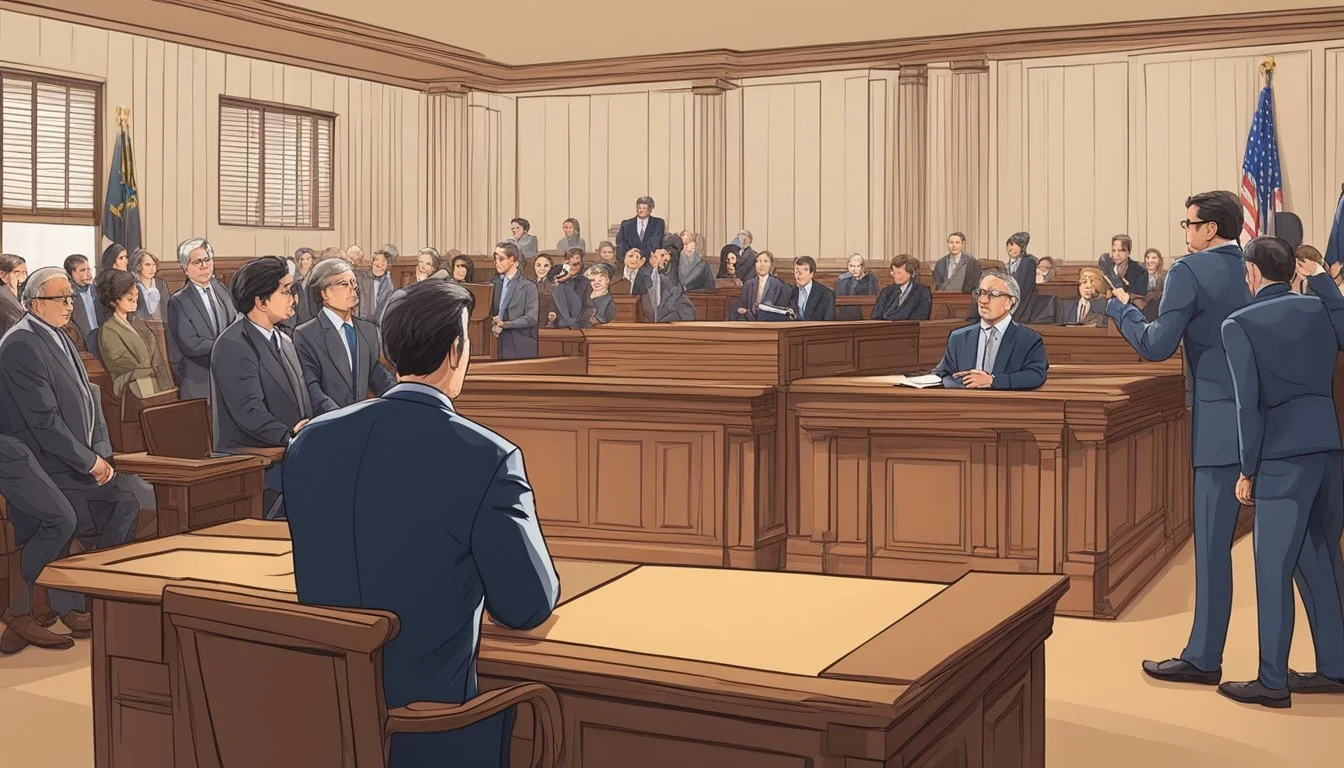American Nightmare: A Case Study in Media Ethics
Examining Sensationalism in News Coverage
The Netflix docuseries "American Nightmare" has reignited debates about media ethics in true crime reporting. This gripping series explores the 2015 abduction of Denise Huskins and the subsequent mishandling of the investigation by law enforcement. The case raises crucial questions about the responsibility of media and law enforcement in sensitive criminal matters.
True crime content walks a fine line between raising awareness and potentially exploiting tragedy. "American Nightmare" serves as a compelling case study for examining these ethical dilemmas. The series sheds light on investigative failures and biases that led to false accusations against innocent parties.
Media coverage of criminal cases can significantly impact public perception and the lives of those involved. The Huskins case demonstrates how hasty judgments and sensationalism can cause additional harm to victims. This docuseries prompts viewers to consider the broader implications of true crime storytelling and its effects on real people.
The Unfolding of an American Nightmare
The abduction of Denise Huskins and the subsequent response from law enforcement revealed a harrowing series of events that shook a California community. This case exposed critical flaws in police procedures and media reporting.
Denise Huskins' Abduction
On March 23, 2015, Denise Huskins and her boyfriend Aaron Quinn awoke to a frightening scene in their Vallejo home. An intruder had broken in, tied them up, and blindfolded them. The perpetrator drugged Quinn and took Huskins away.
Huskins was held captive for two days. Her kidnapper sexually assaulted her twice during this time. On March 25, she was released near her family's home in Huntington Beach, about 400 miles away from Vallejo.
The abductor left a series of emails for law enforcement, detailing ransom demands and providing proof of life. These messages would later play a crucial role in the investigation.
The Vallejo Police Department's Response
The Vallejo Police Department's handling of the case quickly became controversial. When Quinn reported the kidnapping, detectives were immediately skeptical. They accused him of fabricating the story and potentially being involved in Huskins' disappearance.
After Huskins reappeared, police publicly declared the kidnapping a hoax. They likened it to the plot of the movie "Gone Girl." This accusation devastated Huskins and Quinn, who were telling the truth about their ordeal.
The department's rush to judgment had serious consequences. It allowed the real perpetrator to remain free for months. The mishandling of the case also led to a lawsuit against the city, which was later settled for $2.5 million.
Comparisons to 'Gone Girl'
The Denise Huskins kidnapping case drew immediate parallels to the fictional story "Gone Girl" by Gillian Flynn. This comparison shaped public perception and influenced how law enforcement handled the investigation.
Media's Narrative and Confirmation Bias
News outlets quickly latched onto the "Gone Girl" narrative, drawing comparisons between Huskins's case and the plot of Flynn's novel. The story features a wife who stages her own disappearance, leading to suspicion falling on her husband. This framing led to a rush to judgment, with police and media alike skeptical of Huskins's account.
The confirmation bias was evident in how facts were interpreted. Details that seemed to align with the "Gone Girl" plot were emphasized, while contradictory evidence was downplayed or ignored. This bias affected the investigation's direction and public opinion.
Public Reaction to the Case
The "Gone Girl" comparison significantly influenced public perception. Many viewed Huskins's story through the lens of the fictional tale, leading to widespread skepticism and even ridicule. Social media amplified these doubts, with users speculating about potential plot twists reminiscent of the novel.
Some defended Huskins, pointing out the dangers of conflating fiction with reality. Others criticized the media for sensationalizing a serious crime. The case sparked debates about responsible journalism and the impact of pop culture on real-world investigations.
Investigation and Breakthrough
The case took a dramatic turn when a determined detective uncovered crucial evidence. This led to the identification and arrest of the true perpetrator, vindicating the victims.
Misty Carausu's Involvement
Detective Misty Carausu played a pivotal role in cracking the case. She investigated a similar home invasion in Dublin, California. Carausu noticed striking similarities to the Vallejo incident.
Her meticulous work uncovered a critical piece of evidence: a cell phone left at the crime scene. This discovery proved to be the breakthrough needed to solve both cases.
Carausu's persistence and attention to detail were instrumental in linking the crimes. She refused to accept the prevailing narrative and followed the evidence.
Matthew Muller's Arrest
The cell phone evidence led investigators to Matthew Muller, a disbarred lawyer and former Marine. FBI agents arrested Muller at his South Lake Tahoe home in June 2015.
A search of Muller's residence uncovered items connected to the Vallejo kidnapping. These included a pair of goggles similar to those used in the abduction.
Muller's arrest vindicated Denise Huskins and Aaron Quinn. It exposed the flaws in the initial investigation and media coverage.
The Netflix documentary "American Nightmare" later highlighted Muller's capture. It showcased how proper investigative work ultimately brought the true perpetrator to justice.
The Role of Media and Public Perception
Media coverage shapes public understanding of criminal cases. Journalistic storytelling and social media discussions can significantly influence perceptions of guilt, innocence, and the justice system overall.
Impact of Storytelling in Journalism
Journalists play a key role in framing criminal cases for public consumption. Their choices in language, details highlighted, and narrative structure can sway opinions. Press conferences provide official information, but media interpretation affects how it's received.
Ethical reporting requires balancing public interest with privacy concerns. Responsible journalists verify facts, provide context, and avoid sensationalism. However, competitive pressures can lead to rushed or biased coverage.
Crime reporting often focuses on dramatic elements, potentially distorting perceptions of crime rates and trends. This can impact public policy and individual behavior.
Social Media Influence
Social media amplifies and accelerates the spread of information and opinions about criminal cases. Platforms like Twitter and Facebook enable real-time discussions and rapid sharing of news updates.
User-generated content can provide valuable perspectives but also spreads misinformation. Viral posts may outpace fact-checking efforts, shaping narratives before full details emerge.
Social media discussions can pressure law enforcement and influence legal proceedings. Public outcry or support expressed online may affect case priorities and resource allocation.
The echo chamber effect on social platforms can reinforce existing beliefs about crime and justice, potentially widening societal divides on these issues.
Legal Developments and Aftermath
The case of Denise Huskins and Aaron Quinn exposed significant flaws in law enforcement's handling of their ordeal. Legal proceedings that followed aimed to address these shortcomings and provide justice for the victims.
Denied Justice and the Legal System
Huskins and Quinn faced skepticism from law enforcement after reporting the kidnapping. Police initially accused Quinn of being involved in Huskins' disappearance. When Huskins reappeared, authorities labeled the incident a hoax, causing further trauma to the victims. This mishandling of the case highlighted issues within the justice system's approach to complex crimes.
The couple struggled to clear their names as the true perpetrator remained at large. Law enforcement's rush to judgment impeded the investigation and allowed the actual kidnapper to evade capture for months.
Settlement and Vindication
Huskins and Quinn filed a federal civil rights lawsuit against the City of Vallejo and its police department. In 2018, they reached a $2.5 million settlement with the city. This agreement acknowledged the mishandling of their case and the false accusations made against them.
The arrest and conviction of Matthew Muller, the real kidnapper, in 2017 further vindicated Huskins and Quinn. Muller pleaded guilty to kidnapping and was sentenced to 40 years in prison. This outcome provided a measure of closure for the victims and exposed the importance of thorough investigations in kidnapping cases.
Analyzing Law Enforcement's Missteps
The American Nightmare case exposed significant errors in law enforcement's handling of the investigation and interrogation process. These mistakes had profound consequences for the victims and the pursuit of justice.
Investigation Errors
Vallejo police made several critical missteps in their investigation of Denise Huskins' abduction. They failed to secure the crime scene properly, potentially losing valuable evidence. Officers also neglected to conduct a thorough neighborhood canvass, missing potential witnesses.
The police hastily dismissed Aaron Quinn's account of the kidnapping, focusing instead on him as a suspect. This misguided approach led them to overlook crucial leads and waste precious time.
Law enforcement's refusal to consider alternative theories hampered the investigation. They ignored evidence supporting Huskins' abduction, including emails from the kidnapper and voice recordings of Huskins.
Interrogation Techniques and False Confessions
The Vallejo police employed problematic interrogation techniques when questioning Aaron Quinn. They used aggressive tactics and psychological pressure, disregarding his distressed state.
Officers manipulated Quinn during lengthy interrogations, attempting to elicit a false confession. They withheld food and sleep, exploiting his exhaustion and anxiety.
Investigators presented Quinn with false evidence, claiming they had proof of his involvement. This deceptive practice is known to increase the risk of false confessions.
The police failed to properly record the entirety of Quinn's interrogation, violating best practices and potentially obscuring misconduct. This oversight made it difficult to review and assess the fairness of the questioning process.
Cultural Reflection on Crime Narratives
Crime narratives shape public perceptions and reflect societal attitudes towards justice, morality, and human nature. They expose the complex interplay between media, culture, and criminal justice systems.
True Crime Genre and Public Fascination
True crime content has exploded in popularity across various media platforms. Netflix's documentary series and podcasts like "Serial" have captivated millions of listeners and viewers. This genre taps into primal human curiosity about the darker aspects of society.
True crime stories often focus on sensational cases, serial killers, and unsolved mysteries. They provide a safe way for audiences to explore taboo subjects and grapple with moral dilemmas. The public's fascination stems from a mix of fear, empathy, and a desire to understand the criminal mind.
Critics argue that true crime can glorify violence or re-traumatize victims. Ethical concerns arise when filmmakers dramatize real events, potentially blurring the line between fact and fiction.
Myths Versus Reality of Abduction Cases
Hollywood portrayals of abductions often diverge significantly from reality. Films like David Fincher's "Gone Girl" have influenced public perceptions of kidnapping cases. These dramatizations can perpetuate harmful stereotypes and misconceptions about real-life crimes.
Common myths include the prevalence of stranger abductions and the idea that most kidnapping victims are killed within 24 hours. In reality, family members or acquaintances commit the majority of abductions. Media sensationalism can lead to skewed public understanding of crime statistics and risk factors.
Rape myths also persist in popular culture, affecting how society views victims of sexual assault. Documentaries and responsible journalism play a crucial role in debunking these myths and educating the public about the complexities of abduction cases.
The Psychological Impact of False Accusations
False accusations can inflict deep psychological wounds on the accused. Victims often experience severe trauma and struggle to rebuild their lives and reputations in the aftermath.
Trauma and Recovery of the Victims
Survivors of false accusations frequently develop post-traumatic stress disorder (PTSD). They may experience flashbacks, nightmares, and hypervigilance related to their ordeal. Anxiety and depression are common, as victims grapple with feelings of helplessness and betrayal.
Many struggle to trust others, including law enforcement. This can lead to social isolation and difficulty maintaining relationships. Sleep disturbances and concentration problems often interfere with daily functioning.
Recovery requires intensive therapy and support. Cognitive-behavioral therapy and eye movement desensitization and reprocessing (EMDR) can help process trauma. Support groups allow survivors to connect with others who understand their experiences.
Defamation and Damage to Reputations
False accusations, especially of rape or sexual assault, can destroy reputations overnight. News coverage and social media can spread allegations globally before the accused can respond. Even if cleared, the stigma often lingers.
Job loss and financial hardship are common consequences. Some victims face ongoing harassment or threats. Relationships may suffer as friends and family struggle to know what to believe.
Restoring one's good name can take years of effort. Legal action against false accusers may help, but can be costly and re-traumatizing. Some victims advocate for stronger protections against false allegations to prevent others from suffering similar ordeals.
Media Productions and Ethical Implications
Media portrayals of true crime stories raise complex ethical questions about accuracy, bias, and responsibility. Documentaries and Hollywood adaptations each face unique challenges in balancing storytelling with ethical considerations.
Documentary Narratives and Bias
Netflix's true crime docuseries often walk a fine line between informing audiences and potentially sensationalizing tragic events. "The Tinder Swindler" captivated viewers but faced criticism for its narrative choices. Some argued it glorified the criminal's exploits rather than focusing on the victims' experiences.
Documentarians must carefully consider how they frame events and select interview subjects. Presenting a balanced perspective is crucial, as biased portrayals can shape public opinion and even impact ongoing legal proceedings.
Hollywood Interpretations and Responsibilities
When adapting true crime stories, filmmakers like David Fincher take on significant ethical responsibilities. Fictionalized accounts may blur the line between fact and dramatic license, potentially misleading audiences about real events.
Hollywood productions must balance entertainment value with respect for victims and their families. Ethical considerations include:
Accurately portraying key facts
Avoiding glorification of criminals
Respecting the privacy of those involved
Addressing potential impacts on ongoing investigations
Filmmakers should consult with legal experts and those connected to the case to ensure responsible storytelling.









